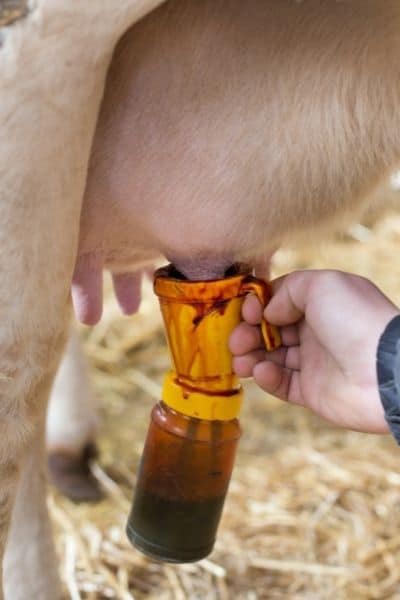Dairy cows are a staple in our food chains and American society, with billions of gallons of milk being bought and consumed in the United States each year. Therefore, knowing how to take care of dairy cows properly is important, allowing them to produce their best milk and satisfy milk lovers all over.
When you do not milk your dairy cow, it can cause milk to build up in the udder. Milk building up in the udder to the point that it becomes full will often cause the cow discomfort right away, and extreme cases can lead to bruising and other health conditions, such as mastitis.
Knowing when and how to milk your cows properly is essential to producing milk consistently. Furthermore, understanding the consequences of not milking your cow and the discomfort it causes is also vital, which is what this article will cover.
What Are the Negative Side Effects of Not Milking Your Cow?

Milking your cow at regular intervals each day is best for the health of your cow. However, when milking is neglected, what is the worst that can happen? Although your cow will not explode, there are some harmful side effects to not milking consistently.
Neglecting to milk your dairy cow will lead to its udder becoming full of milk. The udder holds the milk, and when it becomes full, the cow will become uncomfortable. The amount of time this takes depends on several things, including:
Going from producing a high volume of milk to not milking the cow is not the proper way to dry up a cow. When the udder becomes full, the cow will likely show signs of discomfort and angst. Although this will not kill the cow, other side effects such as mastitis might.
The Dangers of Mastitis
Mastitis can occur in cows when they are not milked or dried properly and is an infection in the udder. This infectious disease should not be ignored, and when not adequately treated, it can spread. In more severe cases, this can lead to the death of the cow.

Mastitis in cows disinfection
The infection starts by creating an inflammatory reaction in the cow’s mammary gland. Depending on various factors, mastitis may produce relatively mild symptoms where the milk is not affected, but inflammatory cells show up in the produced milk.
The symptoms can also become severe and affect the cow’s milk production and general well-being, leading to its ultimate death. Several measures can be taken to prevent mastitis in a dairy cow, but some of the most common are the following:
How Often Should a Dairy Cow Be Milked?
Now that you know the negative impacts of not milking your dairy cow, how do you know how often to milk? Creating a daily schedule for milking your cow is ideal for its long-term health and milking life.
Usually, cows are milked 2-3 times a day. If you have many cattle, it is ideal to use a machine milking system rather than doing it by hand. It is tough to milk cows, even just milking a few 2-3 times a day being a challenging task, but robotic milking systems have become popular within the industry for their efficiency.
Explore our Step-by-Step Guide on How a Milking Machine Operates
The amount of milking needed is also determined upon the amount of milk being produced, or “lactation.” The amount of lactation occurring is determined by the amount of time after calving. Cows produce milk to feed their calves, so a dairy cow must give birth to produce milk.
Time Frame
A dairy cow will reach its peak lactation period at 3-4 weeks after calving. After that, there is a drop-off until you either allow the cow to dry up or impregnate it again.
If your cow is in the beginning stages of high lactation, then it is likely that you will want to milk more often to get the most milk. Dairy cows can produce up to 8 gallons of milk a day, depending on their breed.
Ultimately, setting up a schedule for your cows to be milked based on their lactation period and comfort is best. You will be able to tell with different stress signals from the cow and milk production if you are overmilking or not milking enough.
It is important to know that using a machine to automate the process is one of the best ways to keep a regular rhythm for milking.
What Types of Machines Are Used for Milking Dairy Cows?
Technology makes it so that farmers do not have to spend long hours milking their dairy cows. When looking for the proper machinery to use for milking your dairy cows, consider the number of cows you are planning on milking.
No matter the number of cows you plan to milk, you must also consider the “cow traffic” around the milking station. For those with 20 cows or less, there are multiple portable milking machines available. These are often a sort of pump-like device that you can wheel over to the individual cows.
For herds larger than 20, there are milking systems that you can establish in your barn. Most of the time, these are set up with lines to your individual stalls and are a more permanent part of your barn, allowing you to milk when needed.

Cow milked in robotic milking stand
If larger solutions are needed, you will need to reach out to a commercial dealer and purchase similar equipment from the mid-level in bulk. To take care of the increased capacity of dairy cattle, you will need to install more equipment, including:
What Are the Different Breeds of Dairy Cows?
Most people in the world are familiar with what a cow is, but it is essential to consider the different breeds when producing milk. There are primarily seven dairy breeds in the US that you will find:
Though different breeds produce different amounts of milk, they are all affected in the same way if they do not have a proper rhythm of being milked and are at risk of developing mastitis.
For particular dairy cows that produce more than several gallons a day, stopping to milk them will cause the udder to swell, become inflamed, and even rupture — which is where the term “exploding cow” may come from. It can cause the cow’s ultimate death, so it is of the utmost importance to know the needs of your breed of dairy cow.
Conclusion
Getting your dairy cows on a regular milking schedule is what will end up being best for their health. Not milking your dairy cow causes discomfort to the cow and potentially ends up causing an infection in the udder if not relieved or appropriately treated.
Multiple kinds of machinery can be used to milk your dairy cow and create an automated process. Remember to do your research about what type of dairy cow you have, and learn about the lactation period and how often you should milk your particular cow. Then you will have healthy, happy dairy cows.
